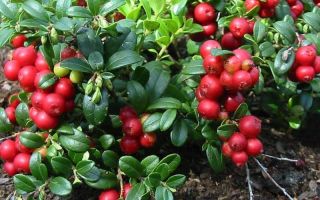Content
- 1 Where does lingonberry grow and what does it look like
- 2 The chemical composition and calorie content of lingonberry
- 3 Why is lingonberry useful?
- 4 Is it possible for lingonberries during pregnancy and breastfeeding
- 5 The healing properties of lingonberry leaves
- 6 Lingonberry recipes in folk medicine
- 7 The use of lingonberries in cosmetology
- 8 Lingonberry in cooking
- 9 When lingonberries are harvested
- 10 How to store lingonberries
- 11 Lingonberry harm and contraindications
- 12 Conclusion
The benefits and harms of lingonberries have made it one of the most popular folk remedies. Its composition is rich in vitamins and microelements that help to cope with pathologies. But traditional medicine is not the only area of using healthy berries.
Where does lingonberry grow and what does it look like
Lingonberry - small red berries, spherical. They have a sour taste, a certain astringency, and a slight bitter aftertaste. The maximum diameter is 8 mm. Flowering period - May, ripening of useful berries - August – September. It has been growing for about 100 years.
The distribution area is large: North and Central Europe, North America and Asia. Grows in tundra and forest areas. Loves coniferous and mixed forests. But you can find a plant in a peat bog, meadow, in mountainous and steppe areas.
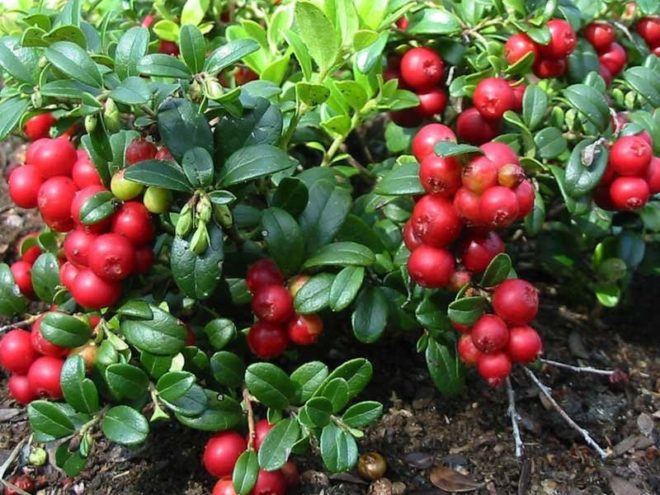
The height of the bush is usually 15 cm, the length of the shoots is up to 1 m. The roots are long, creeping. The culture has leathery, dark green leaves. They shine. Form - elliptical, size - from 5 to 30 mm.
The chemical composition and calorie content of lingonberry
The beneficial properties of the berry are due to its composition. In lingonberries, it is rich, includes vitamins, trace elements and macronutrients.
Vitamin table:
|
Useful vitamins |
Quantity per 100 g |
|
Retinol (A) |
7-9 mcg |
|
Thiamine (B1) |
0.01 mg |
|
Riboflavin (B2) |
0.02 mg |
|
Nicotinic acid (vitamin PP or B3) |
0.2-0.4 mg |
|
Ascorbic acid (C) |
14-15 mg |
|
Tocopherol (E) |
1 mg |
|
Beta carotene |
0.04-0.05 mg |
Table with the content of macronutrients:
|
Useful macronutrients |
Quantity per 100 g |
|
Phosphorus (P) |
15-17 mg |
|
Magnesium (Mg) |
5-8 mg |
|
Sodium (Na) |
5-8 mg |
|
Potassium (K) |
89-91 mg |
|
Calcium (Ca) |
24-26 mg |
Table with the content of trace elements:
|
Useful trace elements |
Quantity per 100 g |
|
Iron (Fe) |
0,4 mg |
|
Manganese (Mn) |
0.65 mg |
Nutritional value per 100 g:
- water - 86 g;
- proteins - 0.6-0.8 g;
- fats - 0.5-0.6 g;
- carbohydrates - 8.3–8.5 g;
- dietary fiber - 2.4-2.7 g
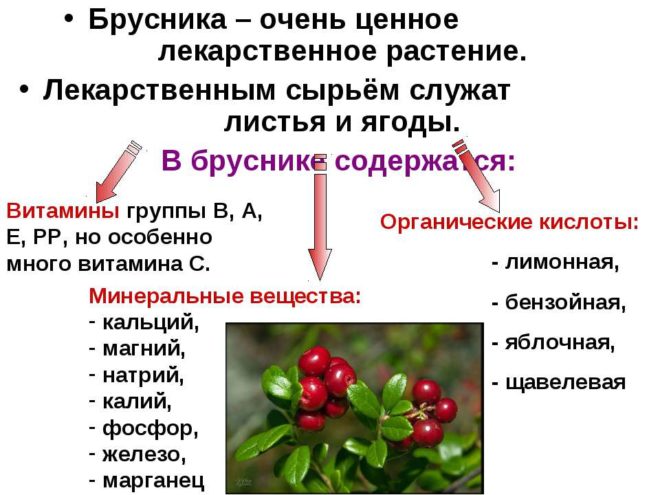
Due to the fact that 86% of the useful berry consists of water, it is low in calories and contains 46 kcal. If you consume only 100 g of fruit, you can get 95% of the required organic acids per day, 32.5% of the daily value of manganese (Mn) and 16.7% of ascorbic acid (C).
Why is lingonberry useful?
This useful berry has a lot of useful properties, for which it is so appreciated.
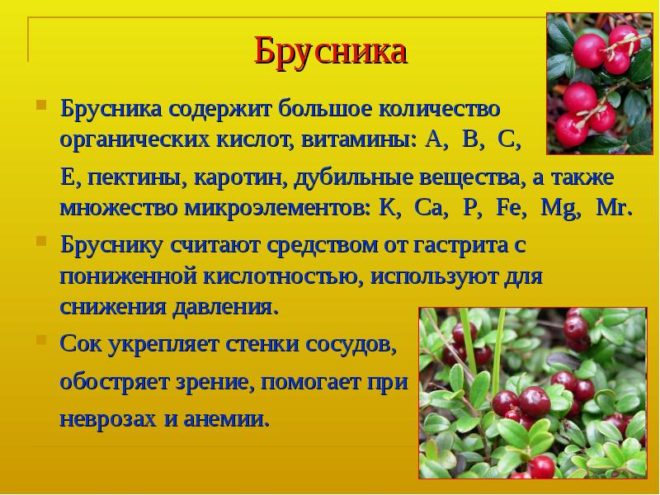
Here is a complete list of the effects that lingonberries have on the body:
- prevents bacterial infections;
- Has quercetin, which reduces inflammation, fights arthritis and other chronic diseases;
- slows down the growth of cancer cells;
- prevents urinary tract infections from spreading throughout the body;
- maintains the health of the oral cavity;
- has a beneficial effect on the work of the brain;
- an effective prophylactic agent for diseases of the cardiovascular type;
- lingonberry for diabetes mellitus is an irreplaceable remedy, as it has hypoglycemic properties that prevent diabetes;
- improves the functioning of the immune system;
- it is used for indigestion, improving digestion;
- vitamin A is good for vision;
- helps to strengthen bones;
- a prophylactic agent for renal diseases;
- fights fungal yeast.
Eating healthy berries can speed up metabolic processes. The product has a mild laxative effect, relieves heat and has an antiseptic effect. Berries are recommended to be consumed with high blood pressure, as well as with excessive glucose levels.

For women
There are many popular recipes for women's health. For example, it has been observed that lingonberry can improve a woman's reproductive function. A useful berry is indispensable for those who want to get pregnant, as it speeds up the process of conception. In addition, she is responsible for the normalization of hormonal levels. If you include lingonberry in your diet, then it will help regulate the menstrual cycle.
Lingonberry with cystitis is a well-known folk way of dealing with the problem. Since it has a diuretic effect and prevents the infection from spreading further, it is very effective. Doctors advise using healthy berries for menopause. They act as a sedative, helping to cope with neurosis during this period. Such actions are also observed: reduction of sweating, prevention of stagnation of blood in the veins.
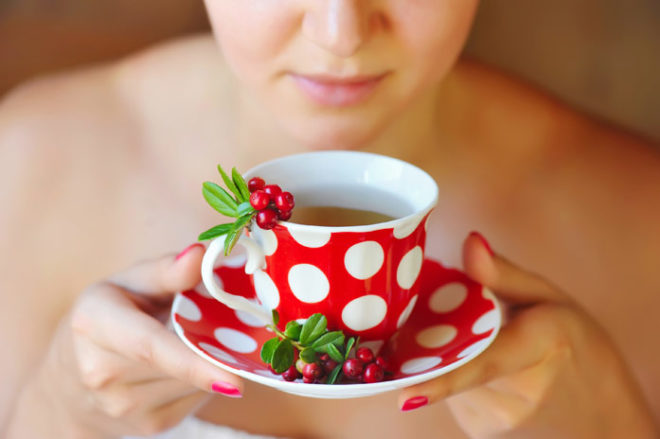
For men
In addition to the above-mentioned beneficial properties that lingonberries have, it is able to cope with prostatitis in men. It is one of the components found in medicines for the disease. The use of lingonberry leaves and the berries themselves in the disinfecting and diuretic effect on the body is undeniable.
Men are advised to consume fresh fruits daily to prevent the occurrence of prostatitis. It also improves male strength.
For children
In its pure form, even a healthy baby cannot be given lingonberries. However, it is possible to include fruit drink in the diet from the fifth month, but only after consulting a doctor.

You need to start complementary foods with 1 teaspoon. By the age of 1, a child can consume from 50 to 100 ml of a drink rich in useful vitamins and minerals. The use of lingonberry fruit drink is that it will help shape the baby's body, fill it with the necessary elements and strengthen the immune system.
If the child does not like the taste of lingonberry (it is sour), then there is an option to make jelly, jelly out of it, or simply sugar the fruit. All this will also have a beneficial effect on the body. Berries should not be given only in case of individual intolerance.
Is it possible for lingonberries during pregnancy and breastfeeding
It is often written that lingonberry is hypoallergenic. This is not true. This berry causes slowly developing intolerances, which appear on the 5-7th day. They are difficult to diagnose and are much more dangerous than the usual allergies, which are recognized by hives or itching. In general, decoctions and infusions of lingonberry leaves should be used with caution and only after consulting a doctor. It is better for pregnant and lactating mothers to forget about them.
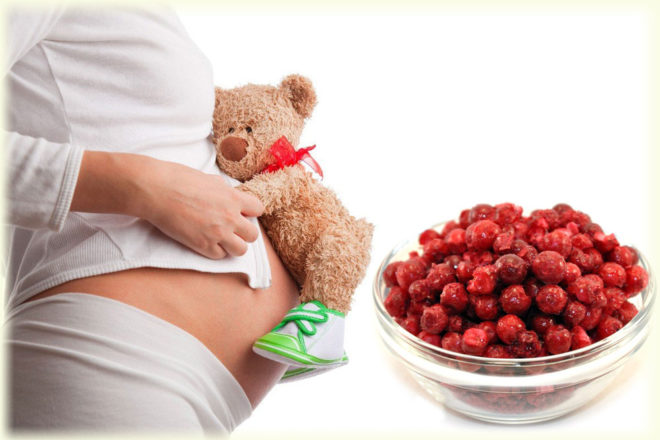
So, while carrying a child in the second and third trimesters, from the second month of lactation, women can eat berries or processed lingonberry products. But only after consulting a doctor! If the doctor permits, you can even be treated with lingonberries or fruit drinks from its berries.
One of the problems of pregnant women is swelling. To get rid of it, it is enough to use lingonberries, which removes excess moisture from the body.Alternatively, prepare lingonberry juice, berry compote or fruit drink. Drinking only 0.25 liters per day, you can forget about puffiness. Only honey cannot be added to the drink. The efficiency will decrease. The course of such treatment is 3 weeks, no more.
Eating lingonberries, you can get rid of or reduce intoxication, anemia, lack of vitamins and minerals. In addition, doctors recommend a berry for neurosis and hypertension. Lingonberry juice has been shown to be beneficial for colds and muscle fatigue in women.
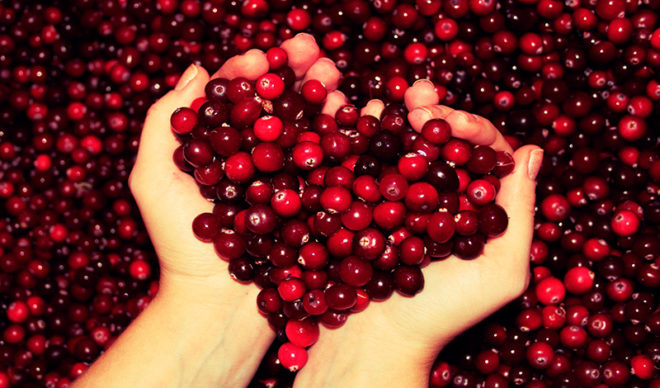
The healing properties of lingonberry leaves
The good news is that harvesting, storing and transporting lingonberry leaves is quite simple. Therefore, you can buy the leaves at any pharmacy. But the use of lingonberry leaves is very wide, since they are in no way inferior to the beneficial properties of the berries themselves, and in some cases even surpass them. Leaves cope with many diseases and heal the body. They have a choleretic, astringent and antimicrobial effect.

A decoction of lingonberry leaves is a well-known grandmother's remedy for colds, diabetes, liver and kidney disease. In addition, the sheets are included in a complex of drugs that fight prostatitis, pyelonephritis, diseases of the respiratory system (bronchitis, pneumonia), inflammation of the oral cavity and edema. They eliminate joint pain and prevent cancer.
Useful substances in the sheets:
- organic acids;
- tannins;
- vitamins;
- arbutin;
- tannin;
- hydroquinone;
- flavonoids.

There are some contraindications: a decoction of the leaves should not be taken by children under 12 years of age and hypertensive patients for more than 2 weeks.
Lingonberry recipes in folk medicine
No wonder our ancestors did not take any medicine. According to them, nature has given us everything we need to eliminate any disease. If you look at the beneficial properties of only one lingonberry, then one cannot but agree with them. Decoctions, teas, medicines and berry dishes solve many problems. Consider recipes for dealing with common diseases.
Cold
Infusion recipe:
- take 200 g of berries;
- pour into a container;
- fill with 500 ml of hot water;
- insist for about an hour;
- add honey if desired.
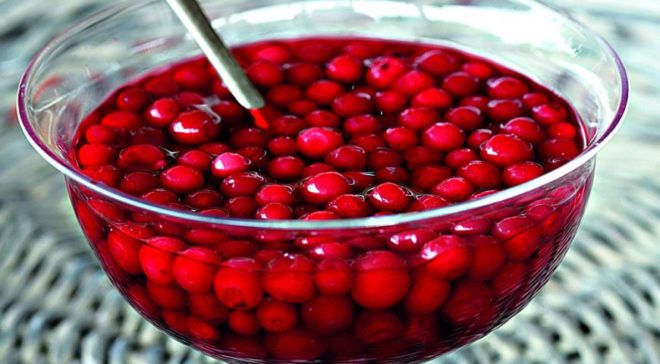
Consume 100 ml of infusion in the morning, lunchtime and evening.
Anemia
Recipe:
- take 40 g of dried leaves;
- 20 g lingonberry berries;
- fill the components with 500 ml of hot water;
- strain after 10 minutes.
Add honey to taste.
Hypertension
Recipe:
- take 10–20 g of crushed leaves (4 tsp);
- mix with 0.5 liters of hot water;
- strain the broth after 30 minutes.
Drink 100 g each morning and evening.
Diabetes
Recipe:
- take leaves of lingonberry, raspberry, black currant and rose hips (equal proportions);
- 1 tbsp. l of the mixture, pour 250 g of boiling water and cook in a water bath for about 10 minutes;
- let it brew for two hours;
- strain before taking a useful broth;
- drink 100 g twice a day.
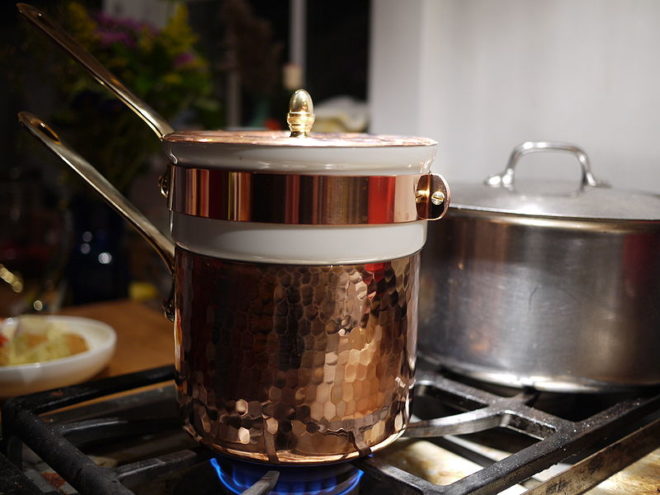
With edema
Lingonberry for edema, recipe:
- take 1 teaspoon of crushed dry leaves;
- pour 250 ml of boiling water;
- insist 30 minutes;
- strain after cooling.
Drink this tea from lingonberry leaves throughout the day in small sips 4 times 50 ml.
The use of lingonberries in cosmetology
Lingonberry is used to prevent dandruff so that hair does not fall out in case of skin inflammation. Berry masks are an excellent moisturizing and tightening agent. They slow down the formation of wrinkles and aging.
Cosmetics contain lingonberry extract.It is an excellent natural antioxidant that has a tonic effect on the skin, making it elastic and protected from external influences.
Face masks
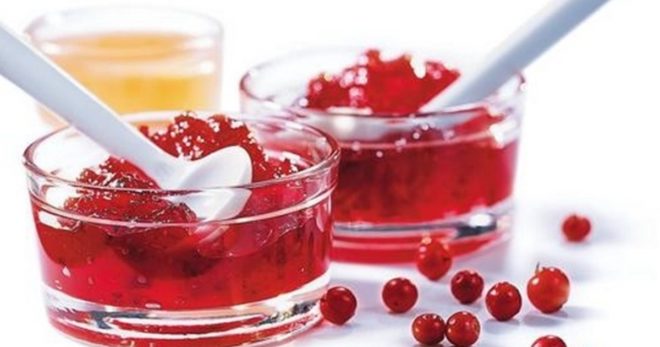
Masks are able to rejuvenate and tighten the skin. Prescription (course - 8 procedures):
- take 1 tbsp. l. chopped lingonberries;
- 1 tbsp. l. wheat flour;
- 1 tbsp. l. grapefruit;
- mix and apply to the skin around the perimeter;
- after 10 minutes, rinse with cool water.
Acne mask:
- mix lingonberry juice and mineral water (highly carbonated);
- wash with a useful mask.
When the bubbles burst, they accelerate blood circulation by expanding the pores into which nutrients from the lingonberry can penetrate.
And to make a face lotion, you need to mix equal amounts of lingonberry, apple and grapefruit juice. It turns out an excellent moisturizing and cleansing effect from the product.
Lingonberry leaves for hair
A decoction of the leaves removes dandruff and strengthens the hair. It makes them soft, voluminous and beautiful. In addition to the fact that berries are useful in any form for hair health, a decoction is also made from the leaves. It is enough for them to rinse clean hair.
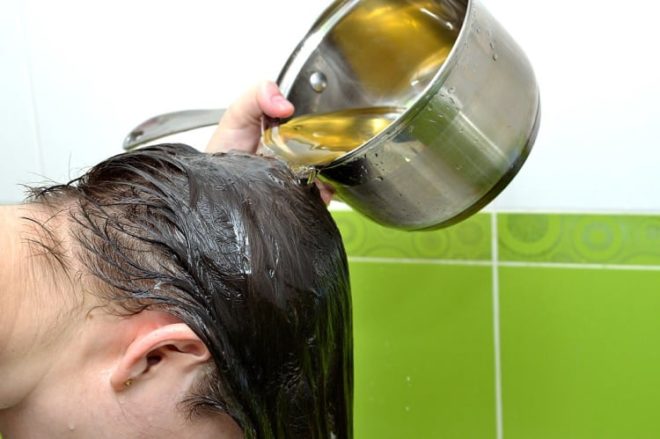
The procedure is performed no more than 2 rubles. in Week.
Lingonberry in cooking
The sweet and sour taste and beneficial properties have made the berry popular in cooking. In its pure form, it may not be to everyone's taste, but if you cook healthy lingonberries correctly, you can please all family members.
Lingonberry dishes:
- lingonberry jam;
- jelly;
- baked goods with berries (muffins, pie, pies, cookies, cake);
- sweet and sour sauce for meat and garnish;
- lingonberry tincture and delicious liqueur;
- fresh berries in sugar;
- juice, fruit drink, jam, jam.
This list of dishes is relative, since knowing the beneficial properties of the berry, cooks can add it to salads and other delicacies.
When lingonberries are harvested
The ideal time to pick berries is the last days of August, the first days of September. You also need to rely on your senses when picking ripe dark red berries. Light-colored fruits are also plucked, because one of their properties is the ability to ripen at home.
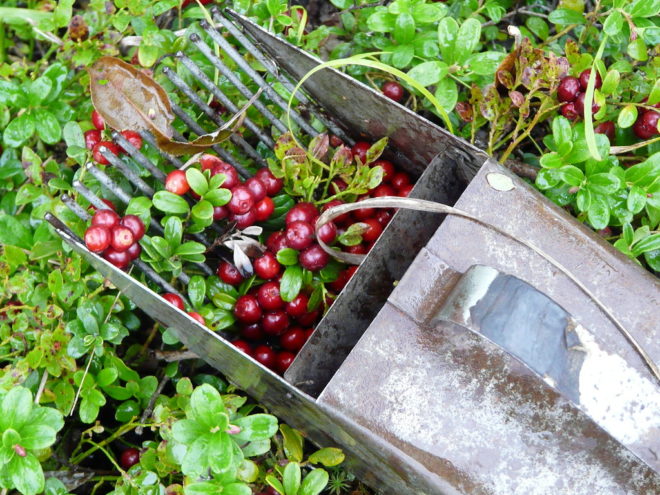
Advice:
- to speed up the ripening of half-ripe fruits, apples or tomatoes are stored with them;
- do not take overripe lingonberries;
- there should be no mold on it;
- healthy berries should be firm, not soft.
When buying lingonberries in a store, attention is paid to the label and the expiration date.
How to store lingonberries
The benefits of frozen lingonberries will be almost the same as fresh ones. It's about benzoic acid. Thanks to her, the berries can be stored in a frozen state for a year without losing their beneficial properties. Fresh fruits are best kept in glass or wood containers with a sealed lid. Another storage option is to pour cold boiled water into a jar and add healthy berries to it.
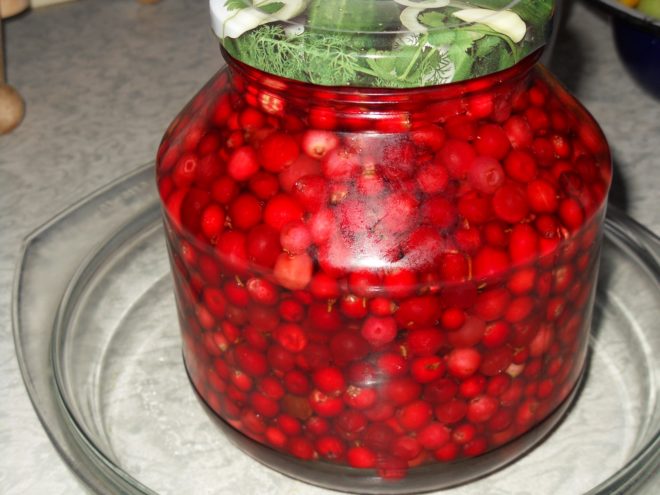
Alternatively, dry the fruits. The benefits of dried lingonberries will remain as they are. And if we talk about leaves, then they are kept in linen or cotton bags, in dishes made of wood and glass. The storage area should be dark.
Lingonberry harm and contraindications
Despite its beneficial properties, it has contraindications. The main one is not to overdo it with the use. With an overabundance, the body can suffer from a number of pathologies. Tinctures and decoctions from the leaves should not be taken by ulcers, which have high acidity. The same applies to personal intolerance and kidney stones.
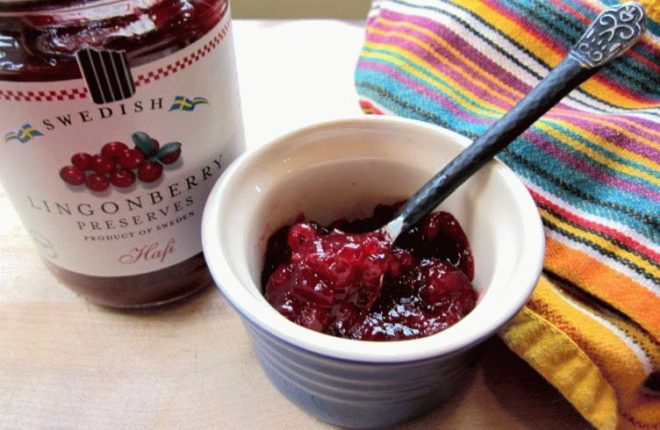
Before taking berries for cystitis, it is better to consult a doctor. And if you use low-quality fruits, then they not only will not bring any benefit, but also lead to poisoning of the body and diarrhea. The acid in lingonberries causes exacerbation of gastritis. And since a healthy berry lowers blood pressure, it is forbidden for hypotonic patients to use it.
Conclusion
Now we know the benefits and harms of lingonberry. Indeed, this is a useful product that copes with many diseases and prevents them.If you know the recipes and use fresh berries, infusions and decoctions from the leaves correctly, then you can not go to the pharmacy for expensive medicines. The same applies to applications in cosmetology and cooking. It is only important to remember that any product must be consumed in moderation!

